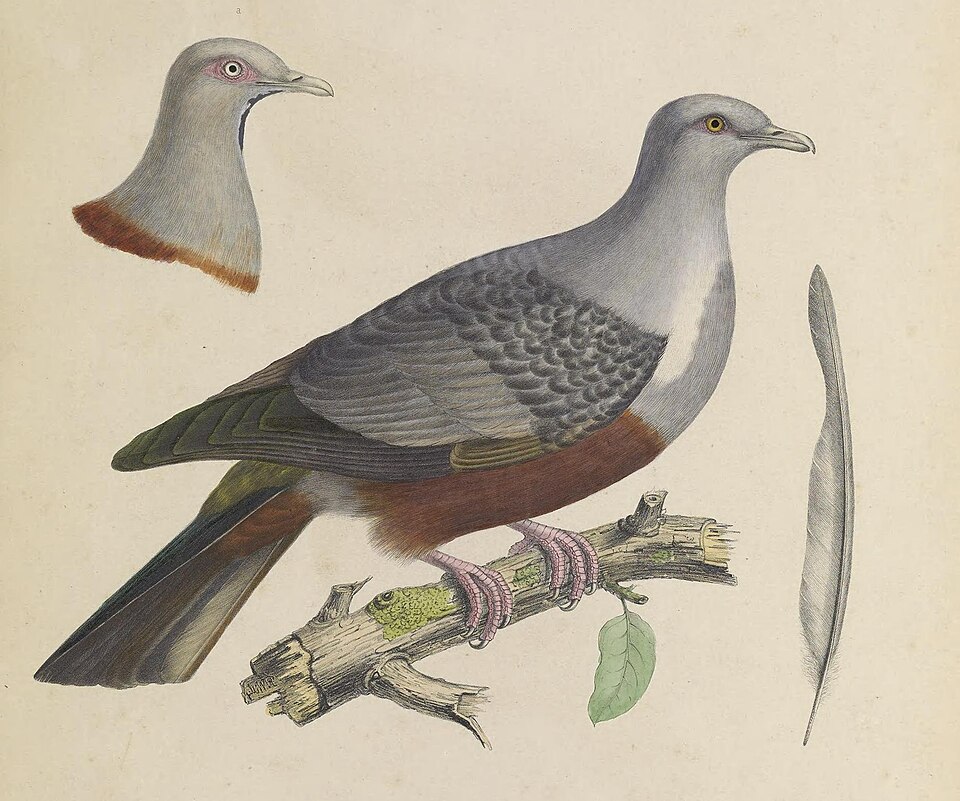Feathers, Fame, and Fraud: The Story of Pauline Knip’s Les Pigeons
With skillful pigeon portraits and a daring act of literary piracy, Pauline Knip secured fame, scandal, and a place in art history.
We don’t tend to imagine pigeons, those scruffy gray denizens of urban centers, as worthy of serious aesthetic appreciation. The familiar feral birds have a large taxonomic family, however, whose members are often elegant and beautiful. Consider the filigreed blue mohawk of the Victoria pigeon, or the ruby-laden breast of the bleeding-heart dove. The diversity and appeal of the bird were well known to Pauline Knip (1781–1851), née Rifer de Courcelles, who produced beautiful watercolor illustrations of more than eighty members of the Columbidae family for Les Pigeons (1811)—a work whose publication history is mired in controversy.

Studying under the well-known natural history illustrator Jacques Barraband, Knip quickly gained attention for her skillful depictions of birds. In 1808, when she was in her late twenties, Knip was commissioned to paint a series of portraits of pigeons and game birds by the Dutch naturalist Coenraad Jacob Temminck for his Histoire Naturelle des Pigeons et des Gallinacés, to be published in fifteen livraisons [installments], and was instructed to base her illustrations on firsthand observations of specimens in Parisian museums as well as sketches supplied by the Swiss-French naturalist Jean-Gabriel Prêtre. The work was to be published in Paris, but, as Temminck lived in the Netherlands, he asked Knip to supervise the engraving and printing of the later livraisons.
This turned out to be a mistake, for Knip decided to maximize personal gain. She modified the cover titles for the later livraisons, changed the title page for the complete work, and ordered the book’s binders to suppress Temminck’s introduction, his Discours sur l’ordre des Pigeons, and index. (This suppression, of course, created inconsistent pagination—for the pages were already printed—which Knip chalked up to a “faute d’impression.”) The new title page read “Les Pigeons par Madame Knip,” crediting “Themminck” for the text but nothing else.
Knip also included a prominent dedication to the empress Marie Louise, Napoleon’s second wife. To keep Temminck in the dark, Knip sent him unadulterated copies of the livraisons as they were originally intended to appear. It was only when he visited Paris in 1812 that Temminck realized what had happened.
While Temminck did try to fight publicly against Knip’s plagiarism, Knip was by now the empress’s natural history painter. Unsurprisingly, Temminck got little support from the press, who were not willing to attack someone in Marie Louise’s favor. He had to satisfy himself by publishing his grievances in a less-popular Dutch edition of his book, which excluded Knip’s illustrations. A second, expanded edition of Les Pigeons (1838–43) was published by Knip in two volumes, featuring text by the French naturalist Florent Prévost and sixty additional plates.

Knip achieved her position due to both her extreme skill as a painter and her Machiavellian scheming. From the glistening neck of the humble stock dove to the Mauritius blue pigeon sporting punk rock headwear, she managed to bring these subtle and exquisite birds to life on the page. Although she is less well known than other natural history artists, such as John James Audubon, Knip worked under the constraints of a society in which it was far more difficult for women to gain recognition, and only a very few managed to do so, especially during their lifetimes.



